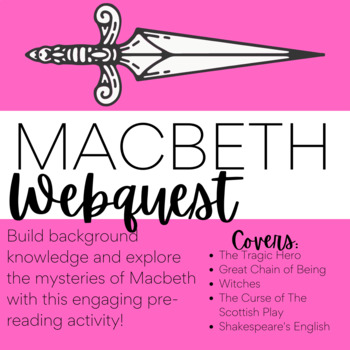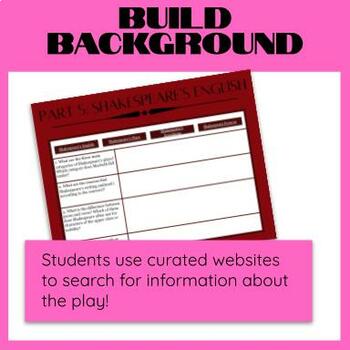Macbeth by Shakespeare Web Quest | Context | Background | Pre-Reading
- Google Slides™
- Internet Activities

Description
Tired of showing a PowerPoint and having students take notes about Shakespeare's language, Elizabethan society, and other necessary contextual topics for Macbeth? Same! I created this WebQuest to provide students with an inquiry- based activity to build the background necessary for students to understand all of the contextual aspects of Macbeth. This activity has multiple entry points and is naturally scaffolded so that every student, IEP, ELL, 504, etc. can all see success!
This activity can be done in so many ways - it is perfect for independent, partner, or jigsaw group work, requires no prep - just assign to your LMS! It’s also PERFECT for a sub day, because it is self-explanatory for students to do on their own.
Here’s what you get:
- A google doc that is fully customizable
- 6 topics to support exploration of the context of Macbeth to engage prior knowledge and support understanding of the plot and themes
- The tragic hero
- The Great Chain of Being
- Witches
- The curse of Macbeth
- Shakespeare’s language
- 17 questions to spark inquiry and focus student research/ exploration
- Curated links aligned with each topic to narrow investigation
- Teaching guide
Students LOVE this activity, because they get to conduct a little research and discover information related to Macbeth on their own terms. It is also structured enough to help students avoid having to sift through websites or good search terms in order to find key information.
You might also be interested in my other Shakespeare products! I’m working on a line for Macbeth, so check back often for more Macbeth resources!
Don't forget that leaving feedback earns you points toward FREE TPT purchases, so let me know how everything is working out!
© Letters and Ink
Please note - this resource is for use by one teacher only. Additional teachers must purchase their own licenses. If you are interested in purchasing several licenses, please let me know. Let’s change education together, one letter at a time!
luci.lettersandink@gmail.com
Let's Stay Connected!





